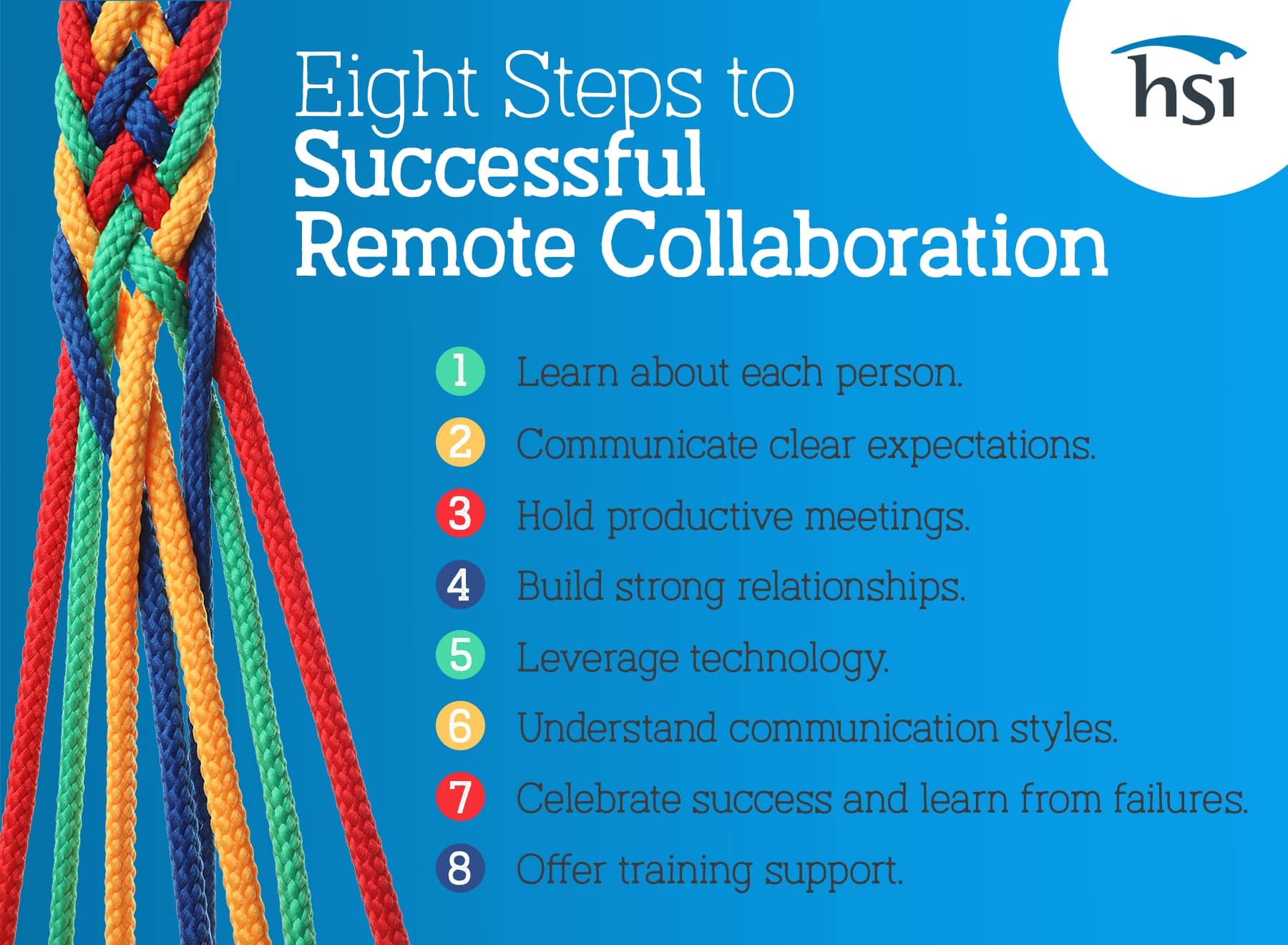8 Steps to Successful Remote Collaboration

I am fortunate to have worked as a member of many remote teams throughout my career. Over 20 years ago, I was living the remote collaboration dream. My manager worked in London for two years while her husband was on sabbatical. It felt very motivating to know the business owner trusted us to make this work. We dialed up our proactive communication with each other, providing more frequent updates than when we worked in the same building. We made it work and enjoyed the freedom.
Since then, I have worked 100% on-site, in hybrid scenarios, and 100% remote in my home office virtual space. Years ago, we did not have cool technology to aid in remote collaboration. Even in today’s tech-savvy world, it still takes more than modern tools to maintain effective remote collaboration, in the true sense of the word. It’s about people, relationships, and communication skills.
What is effective remote collaboration?
Collaboration is the action of working with someone to produce or create something.
“There is no such thing as a self-made man. You will reach your goals only with the help of others.” - George Shinn, former owner of the Charlotte/New Orleans Hornets
If you think about it, even when we were all in the office, there was a level of remote collaboration in place. We worked with people on different floors, and in different buildings, cities, states, etc. Many times, the traditional conference call and group email could be balanced with regular face-to-face meetings, a team lunch, or even a company softball game.
Now remote collaboration is a bit more complex than the definition makes it seem, with so many people working from home, and zero opportunities for in-person meetings, lunchroom chats, or casual conversations. As your company begins hiring remote workers, everyone is in different time zones, so meeting times become more of a challenge.
Embracing remote work
Before all employees can be successful at remote collaboration, whether in a physical space on-site, hybrid, or 100% remote, they must embrace the remote work environment. Statistics show that...
- Since 2009, the remote workforce rose by 159%. (Global Workplace Analytics*)
- 58.6% of the total U.S. workforce are remote workers. (NorthOne*)
- By 2028, 73% of all industries expect to employ remote workers. (Upwork*)
In order to set up your virtual team for success, you need to provide foundational tools and guidance on working remotely. Employees may need help creating a dedicated ergonomic workspace. Non-techy team members may need guidance on home Wi-Fi and gaining access to project management tools, file sharing, and collaboration technology. Pay attention to your company culture, and be sure to support work-life balance. When you work from home, you are also always at the office.
8 Steps to Successful Remote Collaboration
As the business world evolves, with more employees working from home, we need to approach work and relationships a little differently. Hopefully, these eight steps will help your teams not just check the box and finish their work, but truly collaborate, innovate, and solve new problems.

Step #1: Learn about each person
This first step might sound obvious, but it’s even more important when working remotely. It’s going to take more effort to get to know people.
As a manager, you need to invest time learning each individual team member's strengths, work style, and skillsets. As a co-worker, try to learn about the people you are working with in other departments, so you can adjust your approach and interactions with them. Who prefers not to appear on video? Who likes ten minutes of chit-chat before a meeting? Who prefers to get right to the agenda?
Employee 1:1 meet and greets, virtual group training, brainstorming sessions, video conferencing, team-building activities, and virtual happy hours help employees make connections. Ideally, afterward, remote team members feel more comfortable collaborating and sharing ideas.
As I am not only a new, but also 100% remote employee at HSI, it is exciting to spend 30 minutes with key players in 1:1 virtual meetings. It gives me a chance to understand their roles. I can learn how we will interact, grasp their communication style, and get to know a little bit about them as a person.
Step #2: Communicate clear expectations
Effective communication is the foundation of a productive remote team. Team leaders need to communicate remote team members’ roles, what they need to contribute, deadlines, and whom they can count on for support and resources. This keeps the remote teams aligned and focused.
Working with cross-functional remote teams requires each team member to understand their role. In a previous career, my team leaders did not define the expectations of each team member, and they lacked proper project management skills. For example, an action item discussed in a virtual meeting was to summarize the successes of Q1’s marketing campaigns. Unfortunately, meeting notes were not issued, and it was unclear who was responsible. All my remote team members assumed someone else was gathering the information, and the goal was not met.
Step #3: Hold productive meetings
Productive meetings are a critical part of business, in general, not just remote work. I think many of us have experienced meetings that could have been an email. Or, what about the meeting about the meeting?! We’ve all been there!
If you are the meeting host, it’s up to you. Ideally, you issue an agenda prior to the meeting, so attendees can come prepared and make the most of the time together. After the meeting, you provide meeting notes with clear documentation on what was decided, who has action items, and what issues are still outstanding.
You might consider different styles of meetings, such as daily stand-ups, status updates, 1:1 team leader meetings, and training sessions to keep remote teams on track and productive.
I was first introduced to daily 8:00 a.m. stand-up meetings at a worldwide marketing agency during the pandemic. The goal of a stand-up is to increase the team’s productivity by discussing pressing project objectives and asking questions. They are more focused and action-oriented than a status update. The team leaders need to inform the remote teams to know how to prepare for the meeting, what they need to share, and what they will be responsible for presenting during the stand-up. These virtual meetings were critical to campaign execution and delivering success to the demanding client.
Step #4: Build strong relationships
Beyond learning a few details about how people like to work, it is important to build stronger relationships with key employees in your network. Keeping open lines of team communication fosters understanding, confidence, and trust. Being responsible and accountable in your own tasks helps to develop trust among your peers.
It is also helpful to give and receive constructive feedback, both positive and negative. Feedback helps us grow. and is important when collaborating, solving problems, and generating new ideas. Even just saying thank you or complimenting someone on their work in a group email or Slack channel can go a long way.
In my past positions, it was easier to build relationships in person, when you could chat at the coffee machine, plan a group lunch, or schedule a fun food day. Building relationships remotely takes that extra effort.
When I worked at a large supermarket chain, I received approval for a marketing campaign requiring a large budget. I had side conversations with each team member before the proposal meeting. I was able to get their buy-in and answer any questions. This dismissed any reservations about the expense, before the proposal meeting even occurred.
“There is nothing more important in a group remote project than casual conversation. Not just emails and work updates, but the ability to sit back and chat.” - David Rabin, MD, PHD, neuroscientist, health-tech entrepreneur & inventor
Step #5: Leverage technology
Google Drive, SharePoint, Slack, GoToMeeting, Webex, Teams, Chatter, Jabber. Of course, remote tools are important for successful remote team collaboration, but they're not the be-all and end-all. Employees need to be properly trained in the right tool for each company-specific process.
Consider an example of sharing an important document with your boss:
- You could click the “share” button in the browser version of Microsoft Word or Google Docs, and the tool sends an email with a link to your boss.
- You could send a link to your boss in your Microsoft Teams chat or Slack channel.
- You could send an email to your boss with a little more explanation, along with a link.
A few days later your boss asks about the document. They somehow missed it. Can you remember which sharing option you used? You have multiple collaboration tools, but are you more organized?
Consider another example of a team brainstorming session.
How can you recreate the same enthusiasm of people in a conference room, having a funny and lively conversation? How can a virtual session compare to on-site snacking, fidget spinners, and flip charts with colored markers?
An array of design thinking tools with virtual whiteboards may be a perfect solution! These software programs, along with the compatible conferencing platform can achieve similar collaboration dynamics. And how fun would it be to receive a box at your doorstep from the team lead with crayons, Play-doh, and candy!
Step #6 Understand communication styles
This step goes along with getting to know people and building relationships. It’s important to understand personalities and communication styles, and to adjust your processes and interactions, as needed.
Be proactive: Do not get lazy with communication, and be aware of any sudden shifts in it. Make conversations happen daily, if necessary, utilizing the right methods at the right times.
Have a 1:1 meeting, group meetings, status updates, daily stand-ups, chats, policy emails, brainstorming sessions, team-building activities, bonding chats, and conference calls. You might create new formats for written status updates via emails or in shared documents.
Be assertive: Pay attention to each team member on your group calls and video chats, to make sure everyone is heard. It’s easy for more introverted people to sit back and let others dominate the conversation. Some team members may benefit from assertiveness training.
Be persuasive: It is more challenging to communicate persuasively when we are remote. We cannot go to a casual lunch with the person we want to persuade. You may need to adjust your communication style or method. Persuasion may require more formal presentations, one-on-one conversations, or perhaps even repeated conversations.
Step #7: Celebrate successes and learn from failures
Technology can support this step. HSI uses Chatter in Salesforce to celebrate new sales wins (#winalert) and recognize employee birthdays/anniversaries. This is a great tool to connect the entire company for a quick moment of celebration.
Depending upon the complexity of the project, a wrap-up meeting providing project feedback may be helpful. The project lead creates a PowerPoint deck with key background information, graphics, images, metrics, results, lessons learned, etc. They are then shared in a group video call, so you can reinforce the team atmosphere and give everyone a sense of accomplishment.
If it is not necessary to have a wrap-up meeting, it is still nice to provide feedback. A great way to do this is with simple thank you phone calls. My manager always called thanking me for my work on demanding, critical projects. It was such a nice touch, and I will always remember this act of gratitude!
Step #8 Offer training support
Offering an employee training and development program is a best practice for any company, regardless of remote work status. HSI’s Business Skills library has all the courses you need to curate a curriculum for your remote employees as needed, on demand.
From a company perspective, you might ask all employees to watch courses on:
- Creating Collaboration
- DISC Training
- Ergonomics
- Maintaining Mental Health
- Remote Working
- Virtual Leadership
A manager will find it beneficial to suggest training for individuals who need help on specific topics like:
- Assertive Communications
- Persuasive Communications
- Project Management
- Team Building
- Time Management
Many of our clients open their HSI training library to their employees for self-directed learning. Employees can choose off-the-shelf training video courses best suited for their unique needs.


